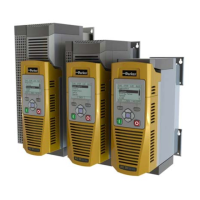D-12 Parameter Reference
AC30V series Variable Speed Drive
Braking
Parameters::Motor Control::Braking
The braking function controls the rate at which energy from a regenerating motor is dumped into a resistive load. This dumping prevents the dc
link voltage reaching levels which would cause an Overvoltage trip.
PNO Parameter Descriptions
0249 Braking Enable
Enables operation of the dynamic braking feature.
0251 Brake Resistance
The value of the dynamic braking load resistance.
0252 Brake Rated Power
The power that the load resistance may continually dissipate.
0253 Brake Overrating
Multiplier that may be applied to
for power overloads lasting no more than 1 second.
0254 Braking Active
A read-only parameter indicating the state of the brake switch.
Functional Description
When enabled, the Braking feature monitors the internal dc link voltage every milli-second and sets the state of the brake switch accordingly.
The Braking feature provides a control signal that is used by the Slew Rate limit feature. This causes the setpoint to be temporarily frozen
whenever the brake is operating because the dc link voltage exceeds the internal comparison level. This allows the stop rate to be automatically
tuned to the characteristics of the load, motor, Drive and brake resistor.
The Braking feature operates even when the motor output is not enabled. This allows the function to continually monitor the energy dumped into
the braking resistor, and the energy dissipated across the brake switch. With this information the Drive is able to deduce the loading on the brake
resistor. Optional trips may be enabled should the switch or resistor be loaded beyond its capabilities.
The "Brake Resistor" and "Brake Switch" trips are disabled by default. To enable these trips, refer to Trips Status page D-121. When using
braking, the brake resistor information must be entered and these two trips enabled.

